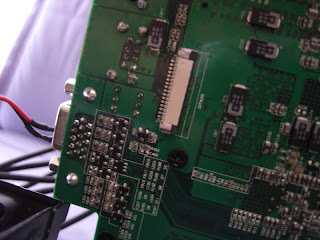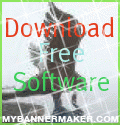Imported Information Of Motherboard
The motherboard is the main circuit board in a PC. It contains all the circuits and components that run the PC.
Major Components found on the motherboard are:
- CPU - the Central Processing Unit is often an Intel Pentium or Celeron processor. It is the heart of every PC. All scheduling, computation and control occurs here.
- BIOS - Basic Input Output System is a non-volatile memory that contains configuration information about the PC. It contains all the code required for the CPU to communicate with the keyboard, mouse video display, disk drives and communications devices.
When a PC is powered on it uses the BIOS 'boot code' to set up many required functions that bring the PC to a point where it is ready to work. - RTC - the Real Time Clock chip keeps date, day and time in a 24 hour format just like your watch. The PC uses this clock to 'time stamp' files as they are created and modified. When you print a file it time stamps the pages as they are printed.
- Chip Set - these are large chip(s) that integrate many functions that used to be found in separate smaller chips on the motherboard. They save space and cost.
The functions performed by these chip sets often broken into two devices with one providing an interface from the CPU to the memory and the other providing controllers for IDE, ISA, PCI and USB devices (see below).
- Power - A 20 pin connector accepts a plug from the power supply. This plug carry DC power to all the circuits on the motherboard.
- Keyboard - A Mini-din 6-pin (round) connector found at the back of the motherboard is where the keyboard plugs in.
- Mouse - A Mini-din 6-pin connector found next to the keyboard connector is where the where the mouse plugs in.
- Display - This connector is not integrated into the motherboard but is included in this list since its function is absolutely necessary. It is a 15-pin, D-shell type connector found on a video card that plugs into the AGP connector of the motherboard (see below).
- IDE - stands for Integrated Drive Electronics. These are 40 pin connectors that provide a place to connect the ribbon cables from the drives (hard and CD/DVD). All data between the motherboard and the drives is carried in these cables. They are not accessible unless the PC cover is removed.
- FDD connector - it is similar in function to the IDE connector. It is a 34 pin ribbon connector that carries data between the motherboard and any floppy drive installed in the PC. Not accessible with PC cover on.
- DRAM - Dynamic Random Access Memory connectors for SIMM and DIMM type memory modules. Not accessible with chassis cover on.
- Serial Connectors
- Standard Serial Connector - This connector has been around in PCs since they first appeared. It was originally located on ISA expansion type cards (see below). Today it is an integral part of newer motherboards. It is a 9- pin, D-shell connector that allows you to connect external devices with serial ports to your PC. The maximum data rate is 115 KB/s.
- USB - Universal Serial Bus This is a relatively new serial bus. Originally specified as low speed, 1.2 Mb/s, it was enhanced to full speed, 12Mb/s. The latest version 2.0 is specified as high speed, 400 MB/s.
Someday USB will completely replace the standard serial connector that has been the workhorse serial port in earlier PCs. USB is now a standard connector on all new motherboards.
Unlike serial and parallel ports, the USB port is designed to power devices connected to it. The devices must be low power devices and must be able to reduce their current draw to less than 0.5uAmps when commanded to do so by the PC.
- Standard Serial Connector - This connector has been around in PCs since they first appeared. It was originally located on ISA expansion type cards (see below). Today it is an integral part of newer motherboards. It is a 9- pin, D-shell connector that allows you to connect external devices with serial ports to your PC. The maximum data rate is 115 KB/s.
- Parallel Connectors
- Centronix or Standard Parallel - This connector has been around in PCs since they first appeared. It has 37-pins and is now integrated on new motherboards. It is usually used to connect your printer to the PC and moves data at about 1MB/s.
- SCSI - Small Computer System Interface moves data at a maximum of up to 80Mb/s. It not integrated into most PC motherboards. It can be added to a PC as an Expansion card (see below). Some printers and hard disk drives use SCSI interfaces.
- Centronix or Standard Parallel - This connector has been around in PCs since they first appeared. It has 37-pins and is now integrated on new motherboards. It is usually used to connect your printer to the PC and moves data at about 1MB/s.
- Expansion Card Connectors - The CPU connects to expansion card connectors through one of the chip set ICs mentioned above. They are located on the motherboard near the rear of the PC. These connectors allow special function cards to plug into and work with the PC.
Before motherboards integrated the serial and centronix connectors they were found on expansion boards that plugged into ISA slots.
Most PCs have the following expansion connector types:- ISA - Industry Standard Architecture connectors have been around since 1980 and first appeared in the IBM XT PC. This type of slot still appears on some newer motherboards so that older expansion boards can still be used. However, many motherboards no longer have ISA connectors on them.
- PCI - Peripheral Component Interconnect is a newer and faster interface that accepts all expansion cards that have a PCI interface.
- AGP - Accelerated Graphics Port is a connector that is designed to work with video cards. Your video display plugs into and is controlled by one of these video cards. Many modern video cards offer enhanced 3D-graphics and fast, full motion video.
- ISA - Industry Standard Architecture connectors have been around since 1980 and first appeared in the IBM XT PC. This type of slot still appears on some newer motherboards so that older expansion boards can still be used. However, many motherboards no longer have ISA connectors on them.




































